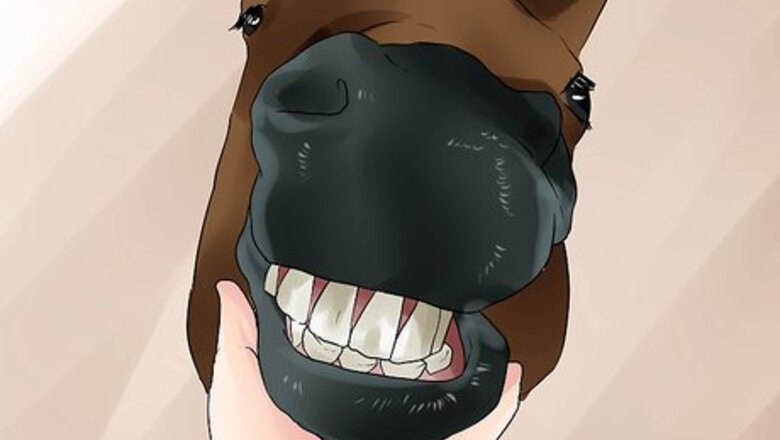
views
Knowing What to Look For
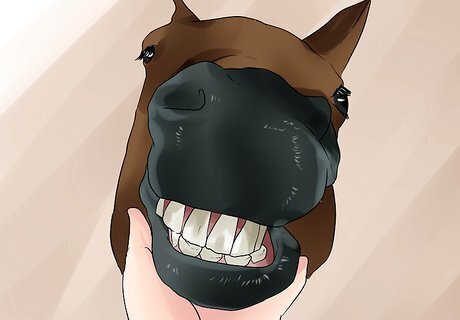
Look a the color of the horse's teeth. The color of a horse's teeth provide a general clue as to horse's age. The milk teeth are white, and the permanent teeth (which erupt at 2 ½ to 5 years of age) that replace them are cream-yellow. With increasing age they turn brown (20 years plus).
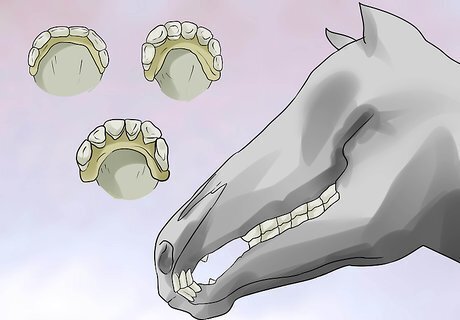
Examine the shape of the chewing surface. Looking at the shape of the chewing surface on a horse's incisors will also help you to determine its age. Milk incisors are oval, adult incisors are circular, and senior incisors are triangular. The cutting or chewing surface of the tooth is the portion of the tooth perpendicular to the long axis of the tooth. It is also sometimes called the “table” of the tooth. The incisors are the teeth located at the front of the mouth, which the horse uses to chop grass. When you peel back the horse’s lips, it is the incisors you see. The teeth at the back of the mouth, which you cannot see without special equipment, are the molars.

Keep an eye out for marks, cups, and stars. These are the names given to various ridges that form a pattern on the biting surface of the horse's incisors. They are formed by deep ridges in the enamel, which wear away over the course of the animal's life to give characteristic shapes. To check for an infundibulum or “cup,” open the horse’s mouth to see the chewing or cutting surface of the incisors. A cup is a deep brown linear mark toward the back of the incisor surface and is present from when the adult tooth first erupts, but it becomes fainter over time. The cup disappears first from the central incisors (those in the center) around 9 years of age, then the middle incisors around 10 years of age, and the corner (outer) incisors at around 12 years of age. Once all the cups have worn away, the horse is said to be "smooth mouthed". "Stars" are a circular brown mark that sits in front of the cup. This first appears at 8-10 years of age and becomes more obvious with age.
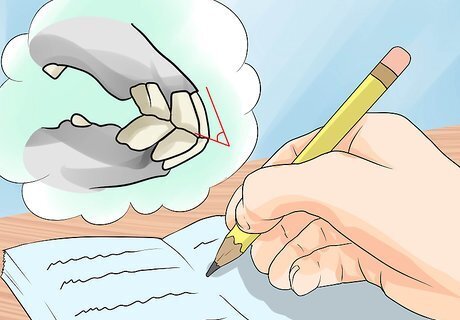
Take note of the angle of the teeth. Young teeth meet in a vertical line. After 5 years of age, the teeth start to slope and meet at an angle. In an aged horse (20 years plus), this sloping angle can be very acute.
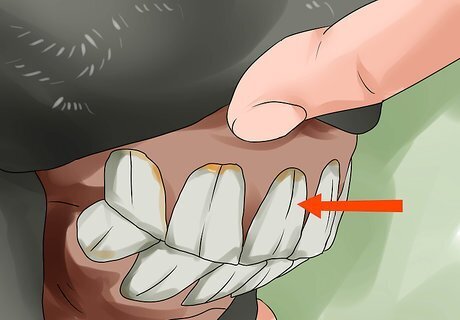
Identify Galvayne's Groove. Galvayne's Groove forms as a result of a slight fold or indentation in the tooth enamel. It is a quirk of nature that it develops at a fairly predictable age and is a useful guide to aging horses between the ages of 10 to 25-30 years old. It is a brown mark that appears at the gum line at the center of the upper corner incisor at approximately 10 years old. It grows down and reaches halfway down the tooth at 15 years before leaving the gum line at 20 years. The mark then grows out completely over the subsequent 5-10 years afterward. For example, a horse where the groove is only present in the lower half of the corner incisor is going to be between 23-25 years old. Horses under the age of 10 and over the age of 30 do not have a Galvayne's Groove, so to avoid jumping to the wrong conclusion, take other factors into account when aging the horse.
Examining the Horse's Teeth
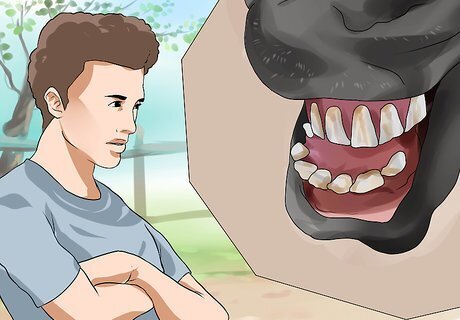
Familiarize yourself with equine dentition. The teeth most easily visible, and those which are most commonly used to age a horse, are the incisors. They are found at the front of the mouth and can be seen by peeling the upper lip up, and the lower lip down. The incisors are used to shear grass, which is then passed to the back of the mouth by the tongue, to be chewed by the molars. There is a gap between the incisors and the molars, called the diastema. In this gap, some horses grow extra teeth called "wolf" teeth (actually the first premolar), but these teeth are usually extracted between 2-5 years of age because they interfere with the bit, and they are therefore not relevant to aging.
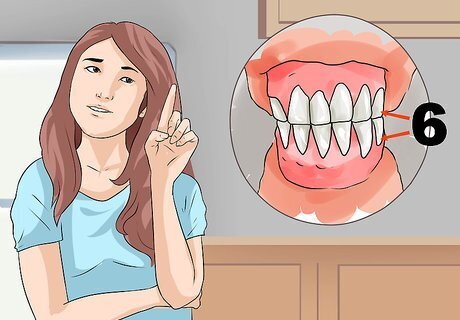
Know how many teeth the horse should have. The horse has 6 incisors in the lower jaw and 6 in the upper jaw. The two middle incisors are called the "central" incisors, and moving outwards there is the "intermediate" and then "corner" incisors (which are the incisors in front of the diastema). The horse also has six upper and six lower cheek teeth on each side. These are grinding teeth and are used for chewing. They are difficult to see at the back of the mouth and play no major role in aging a horse.

Observe the general appearance of the horse when determining its age. Aging a horse is not straightforward and every clue helps. As well as looking at the teeth, look at the horse itself to gain a general picture as to whether it is a youngster who still has some growing to do, an adult in its prime, or a rickety old nag in its golden years. Look at the horse as you approach, stand back even and appraise him. Does he look sprightly and young, doddery and old, or is he a leggy colt with growing still to do?
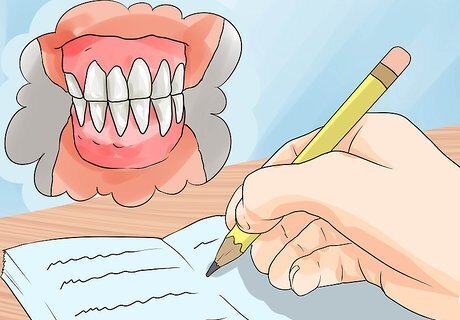
Use a notebook to record your findings. Take your time and don't feel pressured. It helps to have a notebook to record what you see. There are a lot of factors to consider and it's easy to forget one or two. To avoid this, perhaps jot a list down of the things you need to inspect in the horse's mouth, and then note beside each what you saw. This allows you to sit down later and draw all the jigsaw pieces together.
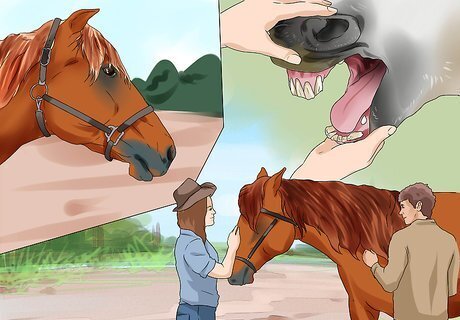
Perform the dental exam under the right conditions. When preparing to examine the horse's teeth, have the horse restrained in a halter, so you have good access to the mouth. Have the horse stand in good light, and if it is raining, perform the examination under cover so that you can concentrate without water running down your back. It helps to have an assistant to hold the horse, or even write down notes, so that you are free to concentrate on the teeth.

Open the horse's mouth. When performing the exam, it is the incisors at the front of the mouth that you will look at. To get a good view, simply lift the top lip and gently push it upwards out of the way. Do the reverse with the bottom lip, pushing it down so that you can clearly see the lower incisors.

Know which dental features to look for. Be meticulous in your exam so that you don't miss anything. Ask yourself: At what angle do the upper and lower incisors meet? Stand to the side of the head and decide at what angle the upper and lower incisors meet. Do they meet in a straight line, or at an angle? If the latter, make an estimate as to the angle and write this down. What color of the incisors? Are they white and milky looking (deciduous teeth), or more yellow and brown (adult teeth)? What shape are the incisors? Are they spade shaped with a narrow neck and wide crown (milk teeth), or are they uniformly "tombstone" shaped (adult teeth)? What shape is the biting edge of the incisors? Is it long and narrow (young teeth), oval (adult), or triangular(old)? Are all the teeth present or have some fallen out?
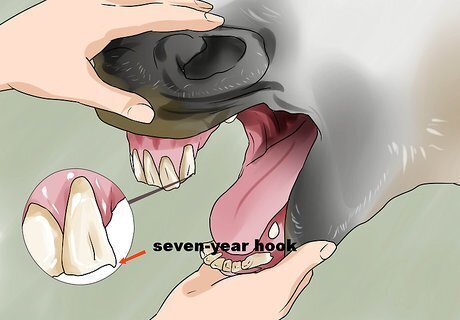
Look for specific marks and grooves. After you have attended to the general observations listed above, you should start looking for specific marks and grooves. Is a hook present on the upper corner incisor? The so called “seven-year hook" is a very useful clue as to the horse's age. Is there a vertical brown mark on the upper corner incisor? If so, does it touch the gum and how far down the tooth does it reach? This is Galvayne's groove and a useful tool to help age the horse. Examine the biting edge of the incisors. Is there a distinct brown line (cup) present, a faint brown line (mark), or a brown spot (star)?
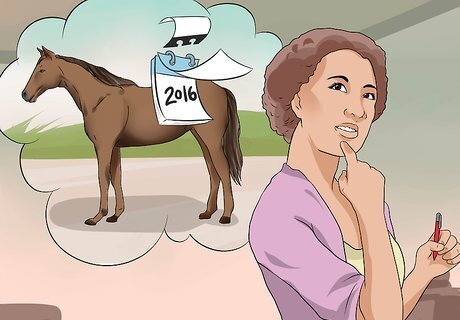
Understand that aging a horse by its teeth gets more difficult as time goes on. It's important to understand that aging a horse by his teeth gets less accurate the older he gets, especially when he is over 10-14 years of age. Factors such as diet can "age" the teeth, whilst vices (such as crib biting), general dental care, and genetics also play a part. For example a stabled horse eating soft alfalfa hay has less wear on his teeth than a horse out on rough pasture, and in comparison the latter's teeth will make him look older than his true age.
Matching Dental Features with Age
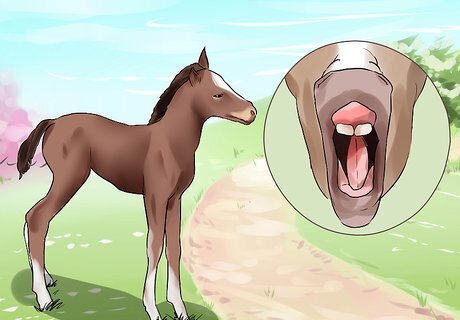
Identify the dental landmarks of a newborn foal. Within days to weeks after its birth, the foal's first milk teeth start to erupt through the gums. The central incisors are generally the first to put in an appearance. The milk teeth are smaller and whiter than permanent incisors. They are shovel shaped with a distinct neck (adult teeth are more "tombstone" shaped). 9 month old: By 9 months of age the foal has a complete set of milk teeth, but not all the teeth have grown down sufficiently to be in wear.
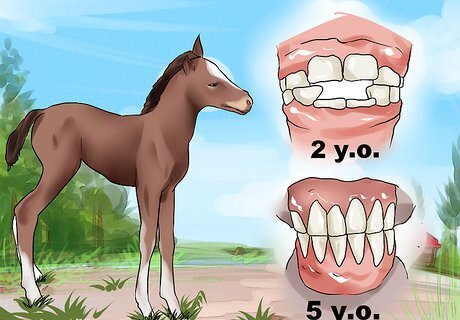
Recognize the dental landmarks of older foals and young horses. You can accurately age a horse from newborn to 5 years of age. Landmarks in this period include the eruption of all the milk (deciduous) teeth, and their replacement by permanent, adult teeth, which is complete by 5 years of age. 12 months old: All milk teeth present but the corner incisors are not long enough to be in wear (they do not touch the matching teeth from the opposite arcade). The milk teeth are white and spade shaped with a distinct neck. 2 years old: The corner incisors meet the opposite arcade and are now in wear (used for cutting grass and chewing). 3 years old: The center milk incisors are replaced by adult incisors. The adult teeth are bigger, blockier and lack a distinct neck. They are more yellow/cream in color than the milk teeth. 4 years old: Adult center and intermediate incisors, but the corner incisors are still milk teeth. 5 years old: All the incisors are now adult teeth.
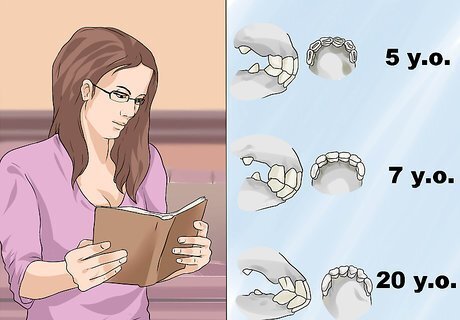
Look for dental landmarks in horses between the ages of 5 and 20 years old. Aging an adult horse is done by taking multiple factors into consideration, such as marks on the chewing surface of the incisors, the angle of the teeth, various grooves in the enamel, and the presence of spurs. 5 year old: Adult teeth newly in wear. Incisors meet at a near vertical angle. Teeth are upright and blocky. The chewing surface of the incisors is concave. The shape of the tooth is cross section is oval. 5-9 years old: Cups are present on the chewing surface of the incisors. These grow out by 9-10 years of age, leaving lighter "marks", which are gone by 12 years of age. 7 years old: The upper corner incisor has a spur or hook where it overhangs the lower incisor. This is known as the "7 year hook" because it disappears by 8 years of age. However, this is an inconsistent finding and may be present on one side of the mouth but not the other. 10 years old: Galvayne's groove appears as a brown-colored mark at the gum line of the upper corner incisors. By the age of 11 years the chewing surface of the incisors is flat. The shape of the tooth in cross section is round. Stars appear (from 8-10 years) on the chewing surface of the incisors and become more distinct with age. 15 years old: Incisors meet at a near 90 degree angle. Teeth are elongated with a chisel like edge. Galvayne's groove is now halfway down the upper corner incisor. 20 years old: Galvayne's groove has disappeared from the gum line of the upper corner incisor.
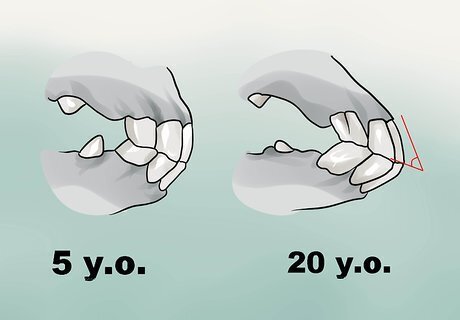
Identify the dental landmarks of a senior horse (20 years plus). This is where the expression "long in the tooth" comes from, because an aged horse has long incisors that meet at an acute angle. The teeth are yellow or brown in color. The incisors are very long and sloping. The upper and lower incisor arcades meet at an acute angle. The cutting surface of the incisors are triangular. Galvayne's groove is absent from the gum line and grows out completely by 25- 30 years of age. 25 years plus, some teeth may start to loosen and fall out.












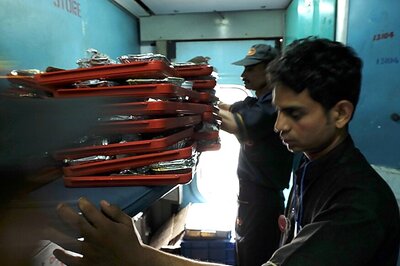



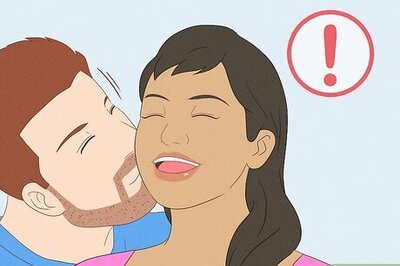



Comments
0 comment